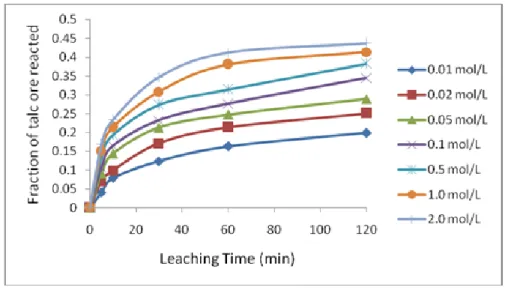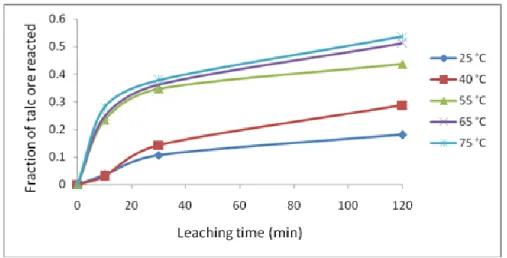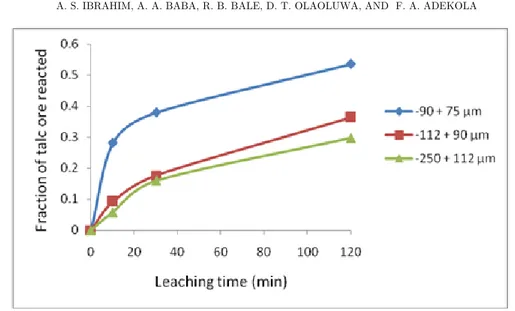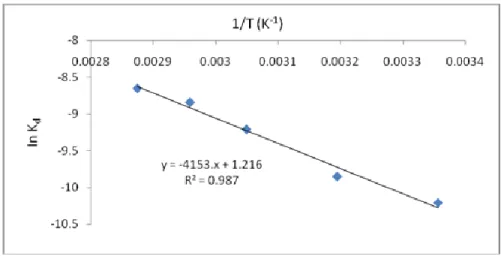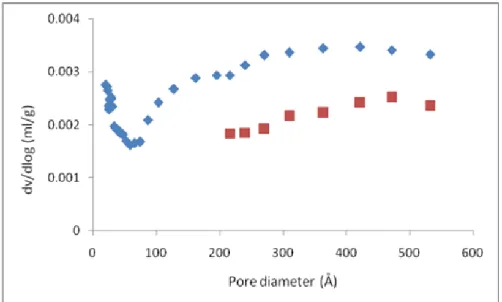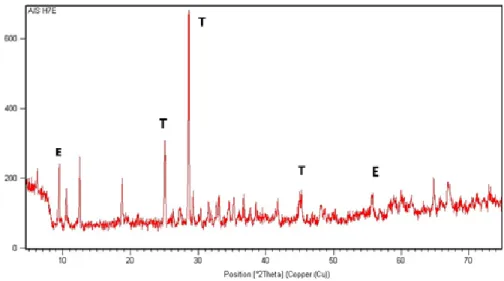DOI: 10.1501/commub_0000000556 ISSN 1303-6017
http://communications.science.ankara.edu.tr/index.php?series=B
Received by the editors: December 20, 2017; Accepted: March 17, 2018.
Key word and phrases: Talc Ore, Leaching, Acetic Acid, Dissolution Kinetics, Porous Material
© 2018 Ankara University Communications Faculty of Sciences University of Ankara Series B: Chemistry and Chemical Engineering
PREPARATION OF MESOPOROUS SILICA FROM A NIGERIAN TALC ORE BY ACETIC ACID TREATMENT
ABDULLAH S. IBRAHIM, ALAFARA A. BABA, RAFIU B. BALE, DAUD T. OLAOLUWA, AND FOLAHAN A. ADEKOLA
Abstract.A study on the preparation of porous silica from a Nigerian talc ore by acetic acid leaching was investigated. The initial and leached talc products were characterized by Energy Dispersive X-ray fluorescence (EDXRF), X-ray diffraction (XRD), Scanning Electron Microscopy (SEM) with Energy Dispersive spectroscopy (EDS) and the N2 adsorption techniques. The influence of acetic acid concentration, reaction temperature and particle size on the ore leaching kinetics were examined. The results of the dissolution rates were found to be significantly influenced by leachant concentration, temperature and decreasing particle size. The dissolution mechanism process followed the diffusion control shrinking core model with the calculated activation energy of 34.53 kJ/mol supporting the proposed mechanism. The leached product has a specific surface area increased to 2.056 m2/g from the initial ore surface area of 0.15 m2/g. At optimal leaching conditions, the pore size distribution calculated by Barret-Joyner-Halenda (BJH) method based on N2 gas isotherms showed the presence of peaks from micropores and mesopores formation, indicating the porous nature of the leached product.
1. Introduction
Talc (Mg3(Si2O5)2(OH)2, a monoclinic, layer-lattice silicate mineral is of significant commercial and industrial importance due to its special structures [1-3]. Talc is a 2:1 type clay minerals and the preparation of porous silica from this type of clay minerals have been reported to have a larger surface and are also influenced by the preparation conditions [4,5]. Porous materials has been widely used as catalyst, catalyst supports, filters, gas absorbers,
dehumidifiers, fire retardants, molecular sieves, ion exchangers and chromatographic agents in fine chemical industries [6-12]. Silicate minerals are excellent raw materials for preparing cheap porous material because of their abundant reservations [13,14]. But the techniques to prepare these materials involve expensive organic raw materials and rigorous chemical reactions. Selective leaching of clay minerals is one of the most possible and useful method for preparing porous materials. The selective leaching method has been reported to be a more attractive option due to the inert nature of talc to acid and more effective in the removal of iron oxides from talc [15-17]. The leaching technique involves the removal of part of the starting material by exploiting the difference in solubility leaving pores within the talc structure and the residue product with a higher specific surface area [13,18-19]. Acid treatment with inorganic acid solution has been reported as the traditional method for talc treatment. Although porous zeolite have been prepared by selective leaching with an alkaline solution and ammonium fluorosilicate [20-23]. However, there has been little or no report on the preparation of porous material by selective leaching using organic acid. Due to the large deposit of silicate minerals scattered across Nigeria and the emerging drive for local content in the petrochemical industries, it is therefore of interest to explore the potential of this vast deposit to produce a cheaper source of porous material using acetic acid. Therefore, the aim of this research was to study the synthesis of porous silica from a Nigerian talc ore including the kinetic behavior of the leaching process. In this context, the effect of acid concentration, particle size and reaction temperature on the leaching rate was studied.
2. Materials And Methods
The starting raw material was natural talc ore from Isanlu, Nigeria. The raw material was ground into various particle sizes. The powdered talc ore samples were treated with acetic acid. Unless otherwise stated, experiments were carried out using the 90-75 µm particle size, due to its large surface area. Leaching experiments were conducted in a 250 mL Pyrex glass reactor equipped with a mechanical stirrer. The required temperature of the reactor contents within ±0.5 °C was adjusted by a thermostatically controlled electric heating mantle. The reactor was filled with 100 ml leachant (acetic acid) with predetermined concentration ranges (0.01 - 2.0 mol/L). For each run, 10 g/L of talc ore was treated with a solution mixture heated from 25 °C to 75 °C between 5 to 120 minutes. Trial runs were performed in order to assess the
optimal leaching conditions. The concentration that gives the maximum dissolution was used for the optimization of other leaching parameters including reaction temperature, and particle size. The residue after leaching was washed with acidulated hot water and then with deionised water. The product was allowed to cool, filtered and dried to constant weight at 80°C before being analyzed. For each experimental run, the fraction of the talc ore dissolved was evaluated from the initial difference in weight of amount dissolved or undissolved at the various leaching time in intervals up to 120 minutes. The product residue at optimal leaching was accordingly characterized to assess the nature of porous material obtained [1,2,24]. In each case, the raw talc (as received) and the leached talc product residue at optimal leaching conditions were subjected to elemental analysis by MINI PAL 4 EDXRF spectrometer. The mineral phases were determined by Empyrean X-ray diffractometer and the morphology was determined by the FEI Nova NanoSEM 230 with an Oxford X-max EDS detector using INCA software to analyze the spectra. Nitrogen gas adsorption-desorption isotherms were measured at 77 K using a micromeritics BET, Tristar II 3020.
3. Results And Discussion 3.1. Characterization of raw powder
The detailed characterization of the -90 +75 µm raw talc ore has been previously reported to contain 52.9% SiO2, 27.2% MgO, 6.32% CaO, 7.4% Fe2O3 and 2.17% Al2O3 as the major constituents. Other compounds detected by X-ray fluorescence occurring from low to trace level include: TiO2 (0.23%), MnO (0.43%), V2O5 (0.05%), Cr2O3 (1.48%) and NiO (0.51%). Also, the Powder X-ray diffraction gave sharp diffraction peaks of well-crystallized talc Mg3Si4O10(OH)2 {19-0770} phases as major constituents. Other associated minerals include chlorite H8Mg6O18Si4 {029-0701} and the
actinolite Al0.83Ca1.68Fe1.42H2K0.04Mg3.65Na0.15O24Si7.38{085-2157}
varieties of amphibole which are Magnesium-rich silicate minerals formed along with talc [24].
3.2 Effects of dissolution variables
The dissolution rate of talc ore was determined as a function of time by changing the acetic acid concentration, reaction temperature and particle size. The fraction of the ore reacted was plotted against leaching time.
Figure 1. Effect of acetic acid concentration on talc dissolution. The effect of acetic acid concentration on the dissolution rate at 55°C was examined. The results plotted in Figure 1 shows there was a steady rise in the rate of dissolution of talc with an increase in the acetic acid concentration and leaching time. However, a further increase in acetic acid concentration up to 1.0 mol/L after 120 minutes, slow down the leaching rate and then remained almost constant. This behavior could be attributed to the fact that as the acetic acid concentration increased, the appearance rate of product increased and as the product reached a saturation value near the solid particle, it forms a difficult soluble solid film layer around the particle. Hence, the dissolution rate slows down after acid concentration of 1.0 mol/L [25,26]. Due to these facts, it is counter-productive to increase the acetic concentration significantly; hence 1.0 mol/L acetic acid was used for further studies.
The effect of the reaction temperature on the dissolution rate was studied at 27 °C - 75 °C temperature range in 1.0 mol/L acetic acid solution.
Figure 2. Effect of reaction temperature on talc dissolution.
It is observed that the dissolution rate is very sensitive to reaction. Although, the reaction seems slow at lower temperature. This result agrees with the fact that ore dissolution is thermally activated. Thus, rates increase as a function of temperature [27].
The effect of particle dimension on the dissolution rate was determined by using 90-75, 112-90, and 250-112 µm by 1.0 mol/L acetic acid solution at 75 °C is summarized in Figure 3.
Figure 3 shows that as the particle diameter decreases the dissolution rate increases. This is due to the increase in the contact surface area with the decreasing particle size per unit weight of the solid ore. At optimal leaching, about 54% of the ore reacted within 120 minutes.
Figure 3. Effect of particle size on talc ore dissolution.
4.1 Dissolution kinetics analysis
The shrinking core model (SCM) was used to describe the behavior of the system. In the establishment of the SCM, the solid reactant is considered to be non-porous and it is initially surrounded by a fluid film through which mass transfer occurs between the solid particle and the bulk of the fluid. The SCM considers that the leaching process is controlled by fluid film and chemical reaction control. The slowest of these steps is considered as the rate-determining step [28,29]. The following set of equations indicates a control through inert/ash layer:
k t ar t C M k d b A B C 0 3 2 1 3 2 1 (4.1)or surface chemical reaction control:
k t ar t C M k r b A B C 0 3 1 1 1 (4.2)where α is the fraction of ore reacted, Kc is the kinetic constant, MB is the molecular weight of the solid, CA is the concentration of the dissolved lixiviant A in the bulk of the solution, a is the stoichiometric coefficient of the reagent in the leaching reaction, ro is the initial radius of the solid particle, ρb density of the solid, Kr, Kd is rate constant (first order) and t is time.
The fit of the experimental data into the integral rate is analyzed by using a computer program and the regression coefficients obtained for each was calculated. From the calculation, it is seen that the best value of regression coefficient was obtain for the diffusion control reaction. Equation (1) gives the best straight line fits with regression coefficient value as 0.9266.
Using the Arrhenius equation, kd = k0 e-Ea/RT, a plot of InKd against1/T gives a straight line with a slope of –Ea/RT and an intercept of InK0 (Figure 4).
Figure 4. Plot of Inkd against 1/T.
Using the Arrhenius equation, the following values were obtained: Ea = 34.53 kJ/mol k0 = 3.37/s
After the evaluation of the activation energy and pre-exponential factor, the kinetics model for the leaching process obtained is consistent with the following expression:
23 e 34.53RTt 37 . 3 1 3 2 1 (4.3)This value of activated energy suggests diffusion control through the inert layer for the ore dissolution process by acetic acid solution [2,30,31].
5. Porous properties
Figure 5 shows the nitrogen adsorption-desorption isotherms of the raw (a) and leached talc product (b). The leached talc product shows an increased nitrogen adsorption compared with the raw sample over the entire P/P0 range. The raw talc almost has no adsorption at the entire P/P0 range and indicates non-porous. The leached product has the type - II isotherm combined with the type IV affirmed that the products are a mixture of micro-porous and meso-micro-porous solids [32]. The hysteresis loop of the sample is similar to type H3, indicative of agglomerates of plate-like particles of slit-shaped pores [33].
The specific surface area of the sample was calculated from these isotherms using the BET method. The measured specific surface of the leached talc at 75°C is 2.056 m2/g as compared to the initial talc surface of 0.15 m2/g. The corresponding pore size distribution (PSD) curves of the raw and leached product evaluated by Barret-Joyner-Halenda method are shown in Figure 6.
Figure 5. N2 adsorption-desorption isotherm of raw (a) and leached talc ore (b) at optimal conditions.
The lack of a clear peak in the pore size distribution of the raw talc confirms its non-porous state [34]. The PSD curve steps toward smaller pore sizes. The leached product shows baseline peaks from micropores and mesopores. The distinct baseline peak is attributed to the presence of mesopores, indicating porous product.
6. Product purity analysis
The leached product formed after optimal leaching was analysed using XRD and SEM techniques. The basic mineralogical and morphological composition of results was compared to the original raw ore. The X-ray diffraction of analysis of the product after leaching with acetic acid at optimum condition is composed primarily of peaks attributed to talc (T) as major constituents and edenite (E) occuring from low to trace level (≤ 2%) was also observed as shown in Figure 7.
Figure 7. X-Ray diffraction pattern of leached product of talc, showing the identified compounds with their respective Joint Committee on Powder Diffraction Standard file number used in peaks attribution. (T) Mg3Si4O10(OH)2 (talc) {19-0770}, (E) AlCa2H2Mg5NaO24Si7 (edenite) {023-1405}.
The SEM images of leached talc product with the diameter -90 + 75mm of 1 mol/L acetic acid solution at 750C at different magnifications are presented in Figure 8.
Figure 8. SEM and EDS images of leached talc product by acetic solution at optimal conditions.
From Figure 8, the SEM results depicted an elongated layer surface, tabular with minor flakes in fine shreds. Some possible impurities which have not been leached occur in the leached residual product.
4. Conclusion
In this study, talc ore was treated by acetic acid solution under various conditions to prepare porous silica by selective leaching. The dissolution kinetics of talc in acetic acid solutions were studied; it was found that the reaction rate increases with an increase in acetic acid concentration, reaction
temperature with a decrease in particle size. The dissolution process was found to be diffusion control kinetics with an activation energy of 34.53 kJ/mol calculated from the experimental data supports the proposed mechanism. The specific surface area of the leached product by BET was found to increase from 0.15 m2/g to 2.056m2/g. The pore size distribution calculated by BJH method based on N2 gas isotherms shows baseline peaks from presence of micropores and mesopores formation indicating the possible preparation of the high grade porous product.
Acknowledgement
The authors are grateful to Miranda Waldron of the Centre for Imaging & Analysis, University of Cape Town, South Africa for assisting with SEM, EDS and BET analyses.
Özet
Nijerya talk cevherinden asetik asit liçi ile gözenekli silikanın hazırlanması üzerine bir çalışma araştırıldı. Başlangıç ve liç edilmiş talk ürünleri, Enerji Dağılımlı X-ışını floresansı (EDXRF), X-ışını kırınımı (XRD), Enerji Dağılımlı Spektroskopi (EDS) ile Tarama Elektron Mikroskobu (SEM) ve N2 adsorpsiyon teknikleri ile karakterize edildi. Cevher liçi kinetikleri üzerine asetik asit konsantrasyonunun, tepkime sıcaklığının ve partikül büyüklüğünün etkisi incelendi. Çözünme oranlarının sonuçlarının, sızıntı konsantrasyonu, sıcaklık ve azalan parçacık büyüklüğünden önemli ölçüde etkilendiği bulundu. Çözülme mekanizması işlemi, önerilen mekanizmayı destekleyen 34.53 kJ / mol'lük hesaplanmış aktivasyon enerjisi ile difüzyon kontrol daraltma çekirdek modelini takip etti. Liç edilmiş ürün, 0.15 m2/g başlangıç cevher yüzey alanından 2.056 m2/g' ye kadar spesifik bir yüzey alanına sahiptir. Optimal süzdürme koşullarında, N2 gaz izotermlerine dayanan Barret-Joyner-Halenda (BJH) yöntemiyle hesaplanan gözenek büyüklüğü dağılımı,
mikro-gözeneklerden ve mezo-gözenek oluşumundan gelen piklerin
mevcudiyetini gösterdi ki bu, liç edilmiş ürünün gözenekli doğasını belirtmektedir.
References
[1] [1] R.P. Orosco, M. Ruiz, C. Del, L.I. Barbosa, and J.A. Gonzalez, Purification of talc by chlorination and leaching. International Journal of Mineral Processing, 101 (2011) 116-120.
[2] H. Yang, C. Du, Y. Hu, S. Jin, W. Yang, A. Tang, and E.G. Avvakumov, Preparation of porous material from talc by mechanochemical treatment and subsequent leaching. Applied Clay Science, 31 (2006) 290-297.
[3] P.W. Harben, and M. Kuzvart, Talc and soapstone In: P.W. Harben., and M. Kuzvart (eds.) Industrial Minerals: A Global Geology, London, Industrial Minerals Information Ltd, Metal Bulletin PLC, (1996) 407-417.
[4] K. Okada, J. Temuujin, Y. Kameshima, and K.J.D. MacKenzie, Selective acid leaching of talc. Clay Science 12 (2003) 159-165.
[5] J. Temuujin, K. Okada, T.S. Jadambae, K.J. Makenzie, and J. Amarsanaa, Effect of grinding on the leaching behaviour of pyrophyllite. Journal European Ceramics Society, 23 (2003) 1277-1283.
[6] F. Schüth, and W. Schmidt, Microporous and mesoporous materials. Advanced Materials 14 (2002) 629-638.
[7] C.Y. Chen, S.L. Burkett, and H. Li, Studies on mesoporous materials, synthesis mechanism of MCM-41. Microporous Materials, 2 (1993) 27-34.
[8] R. Herino, Nanocomposite materials from porous silicon. Materials Science & Engineering. B, Solid-State Materials for Advanced Technology, 69/70 (2000) 70-76.
[9] K. Okada, A. Shimai, S. Hayashi, and A. Yasumori, Adsorption properties of microporous silica prepared from metakaolinte by selective leaching method. Clay Science, 11 (1999) 73-82.
[10] J. Cejka, and B. Wichterlova, Acid-catalyzed synthesis of mono- and dialkyl benzenes over zeolites: active sites, zeolite topology, and reaction mechanisms. Catalysis Review Science and Engineering, 44/3 (2002) 375-422.
[11] A.J. Aznar, E. Gutierrez, P. Diaz, A. Alvarez, and G. Poncelet, Silica from sepiolite: preparation, textural properties, and use as support to catalys. Microporous Materials, 6 (1996) 105-114.
[12] D.S. Nikitin, V.A. Zhukov, V.V. Perkov, S.P. Buyakova, and S.N. Kul’kov, Preparation of porous ceramics from nanocrystalline zirconia and their microstructure. Inorganic Materials, 40/7 (2004) 760-776.
[13] J. Temuujin, K. Okada, T. Jadambaa, K. Mackenzie, and J. Amarsanaa, Effect of grinding on the preparation of porous material from talc by selective leaching. Journal of Materials Science Letter, 21/20 (2002) 1607-1609.
[14] J. Temuujin, and K. Okada, Zeolite formation by hydrothermal treatment of waste solution from selective leached kaolinit. Materials Letters, 52 (2002) 91-95.
[15] J. Temuujin, K. Jadambaa, and G. Burmaa, Characterisation of acid activated montmorillonite clay from Tuulant (Mongolia). Ceramics International, 30 (2004) 251-255.
[16] K. Okada, A. Shimai, T. Takei, S. Hayashi, A. Yasumiri, and K.J.D. Mackenzie, Preparation of microporous silica from metakaolinite by selective leaching methods. Microporous Mesoporous Material, 21 (1998) 289-296.
[17] L.A. Castillo, S.E. Barbosa, P. Maiza, and N.J. Capiati, Integrated process for purification of low grade talc ores. Journal of Particulate Science and Technology, 32/1 (2014) 1-7.
[18] C. Maquedaa, A.S. Romero, E. Morillo, and J.L. Pe´rez-Rodrıguez, Effect of grinding on the preparation of porous materials by acid-leached vermiculite. Journal of Physics and Chemistry of Solids, 68 (2007) 1220-1224.
[19] M. Harkonen, and R. Keiski, Porosity and surface area of acid-leached phlogopite: The effect of leaching conditions and thermal treatment. Colloids and Surfaces 11/3 (1984) 323-339.
[20] P. Komadel, J. Madejová, In: F. Bergaya, B.K.G. Theng, and G. Lagaly, (ed.,) Handbook of Clay Science, Developments in Clay Science, Elsevier, Amsterdam, Chapter 7.1 (2006).
[21] M. Ogura, S. Shinomiya, J. Tateno, Y. Nara, E. Kikuchi, and M. Matsukata, Formation of uniform mesopores in ZSM-5 zeolite through treatment in alkaline solution. Chemistry Letter, (2000) 882-888.
[22] G. Jozefaucik, and G. Bowanko, Effect of acid and alkali treatment on surface areas and adsorption energies of selected minerals. Clay Mineral, 50 (2002) 771-783.
[23] R. Le Van Mao, J.A. Lavigne, B. Sijariel, and C.H. Langford, Mesoporous aluminosilicates prepared from zeolites by treatment with ammonium fluorosilicate. Journal Material Chemistry, 3 (1993) 679-683.
[24] A.A. Baba, A.S. Ibrahim, R.B. Bale, F.A. Adekola, and A.G.F. Alabi, Purification of a Nigerian talc ore by acid leaching. Applied Clay Science, 114 (2015) 476-483.
[25] B. Donmez, F. Demir, and O. Lacin, Leaching kinetics of calcined magnesite in acetic acid solutions. Journal of Industrial and Engineering Chemistry, 15 (2009) 865–869.
[26] O. Lacin, B. Donmez, and F. Demir, Dissolution kinetics of natural magnesite in acetic acid solutions. International Journal of Mineral Process, 75 (2005) 91-99.
[27] K. Lund, H. Fogler, and C.C. McCune, Acidization-I: The dissolution of dolomite in hydrochloric acid. Chemical Engineering Science, 28/3 (1973) 691-700.
[28] Q. Levenspiel, Chemical Reaction Engineering, 2nd ed. Wiley, New York, NK (1992).
[29] C. Edtmaiera, R. Schiessera, C. Meissla, W.D. Schuberta, A. Bockb, A. Schoenb, and B. Zeilerb, Selective removal of the cobalt binder in WC/Co based hardmetal scraps by acetic acid leaching. Hydrometallurgy, 76 (2005) 63-71. [30] A.A. Baba, F.A. Adekola, and R.B. Bale, Development of a pyro- and
hydro-metallurgical route to treat zinc-carbon batteries. Journal of Hazardous Materials, 171/1-3 (2009) 837-844.
[31] E.A. Abdel-Aal, and M.M. Rashad, Kinetic study on the leaching of spent nickel oxide catalyst with sulfuric acid. Hydrometallurgy, 74 (2005) 189-194.
[32] R. Ishii, M. Nakatsuji, and K. Ooi, Preparation of highly porous silica nanocomposites from clay mineral: a new approach using pillaring method combined with selective leaching. Microporous and Mesoporous Materials, 79 (2005) 111-119.
[33] K.S.W. Sing, D.H. Everett, R.A. Haul, L. Moscou, R.A. Pierotti, J. Rouquerol, and T. Siemieniewska, Reporting physisorption data for gas/solid systems with special reference to the determination of surface area and porosity (Recommendations 1984). Pure and Applied Chemistry, 57 (1985) 603-619. [34] Okada, N. Arimitsu, Y. Kameshima, A. Nakajima, and K.J.D. MacKenzie,
Preparation of porous silica from chlorite by selective acid leaching. Applied Clay Science, 30 (2005) 116-124.
Current Address: ABDULLAH S. IBRAHIM: Department of Industrial Chemistry, University of Ilorin, 240003 Ilorin, NIGERIA
E-mail Address: herbdul@yahoo.com
ORCID:https://orcid.org/0000-0001-5193-5664
Current Address: ALAFARA A. BABA: Department of Industrial Chemistry, University of Ilorin, 240003 Ilorin, NIGERIA
E-mail Address: alafara@unilorin.edu.ng ORCID: https://orcid.org/0000-0002-6978-7898
Current Address: RAFIU B. BALE: Department of Geology and Mineral Sciences, University of Ilorin, 240003 Ilorin, NIGERIA
ORCID: https://orcid.org/0000-0001-6560-4735
Current Address: DAUD T. OLAOLUWA: Department of Industrial Chemistry, University of Ilorin, 240003 Ilorin, NIGERIA
E-mail Address:daud4reals@gmail.com
Current Address: FOLAHAN A. ADEKOLA: Department of Industrial Chemistry, University of Ilorin, 240003 Ilorin, NIGERIA
